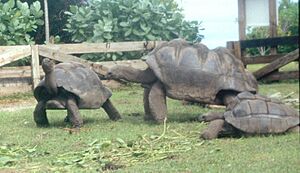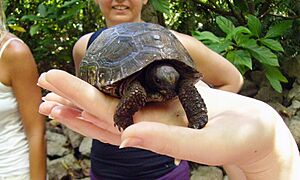Seychelles giant tortoise facts for kids
The Seychelles giant tortoise (Aldabrachelys gigantea hololissa), also called the Seychelles domed giant tortoise, is a type of tortoise. It belongs to the Aldabrachelys group.
These tortoises used to live on the big central Seychelles islands. But European sailors hunted many of them. By about 1840, people thought this tortoise had completely died out. Another type of tortoise, the Arnold's giant tortoise, which lived on the same islands, was also thought to be gone.
However, the Seychelles giant tortoise was found again recently. As of October 2019, there are a little over one hundred of these tortoises left. Many had been brought back to live in the wild on islands like Silhouette. But in 2011, a company called the Seychelles Islands Development Company moved them from the island.
Contents
What Does the Seychelles Giant Tortoise Look Like?
The three types of Aldabra-Seychelles giant tortoises can be told apart by the shape of their shells. However, many tortoises living in zoos or special centers might have shells that are not perfectly shaped. This can make them harder to identify.
The Seychelles giant tortoise (A. g. hololissa) has a wide, flat back with raised scutes, which are like plates on its shell. It is usually a brownish-grey color. In comparison, the true Aldabra giant tortoise (A. g. gigantea) has a round, dome-shaped shell and is black.
What Do They Eat?
Like other tortoises, the Seychelles giant tortoise does not eat only plants. People have seen these tortoises eating birds, crabs, and even bones. This shows they have a varied diet.
How Long Do They Live?
Giant tortoises are some of the longest-living animals on Earth. Some Aldabra giant tortoises are believed to be over 200 years old. It is hard to know for sure because they often live longer than the people who study them!
One famous tortoise named Adwaita was said to be one of four tortoises brought from the Seychelles Islands. They were gifts to Robert Clive of the British East India Company in the 1700s. Adwaita came to the Calcutta Zoo in 1875. When he died in March 2006, he was thought to be 255 years old, making him one of the longest-living animals ever recorded.
As of 2024, Jonathan is a Seychelles giant tortoise living on Saint Helena island. He is thought to be the oldest living land animal on Earth, at 192 years old. Another very old tortoise is Esmeralda, an Aldabra giant tortoise in the Galapagos Islands, who is 180 years old.
There is also a story about a tortoise kept by a French explorer named Chevalier Marc-Joseph Marion du Fresne. This tortoise lived in a fort for 118 years. It died in 1918 when it became blind and accidentally fell from a gun turret.
Extinction and Rediscovery
Many different types of giant tortoises once lived in the Seychelles. These tortoises were large and slow. They were also reportedly friendly and not afraid of humans. Sailors and settlers killed thousands of them, which quickly led most populations to extinction.
For a long time, people thought that only the Aldabra giant tortoise had survived. However, in 1995, it was suggested that some Seychelles tortoises might still exist in captivity.
Reports of strangely shaped captive tortoises made the Nature Protection Trust of Seychelles look into their identity. Dr. Justin Gerlach and Laura Canning studied museum specimens of the 'extinct' Seychelles subspecies. They found that some living tortoises had features of the tortoises thought to be extinct.
Recent scientific studies on the genetics of Seychelles and Indian Ocean tortoises have shown different results. Some studies suggest there was only one species with many variations on the islands. Others suggest there were three different, but closely related, species. These different ideas come from studying different genes.
Conservation Efforts
Using DNA testing, tortoises of the "extinct" subspecies were found. The Nature Protection Trust of Seychelles took them in for conservation. A special breeding program started in 1997 on Silhouette Island. For several years, the female tortoises laid eggs that could not hatch. But in November 2002, eggs laid by a young female began to hatch!
By the time the Nature Protection Trust of Seychelles had to leave Silhouette Island in March 2011, they had produced 40 young Seychelles giant tortoises. The Islands Development Company decided to move the Trust and did not allow wild tortoises to live on the island. This forced the Trust to find new homes for the tortoises.
The private Cousine Island agreed to take the Seychelles tortoises. In April 2011, the tortoises moved to Cousine. If they had been able to stay on Silhouette Island, they would have created a separate wild group. Now, they will mix with the Aldabra tortoises already on Cousine Island. The Nature Protection Trust of Seychelles is happy that they produced many young tortoises. These young tortoises will live for at least 100 years. This long lifespan gives hope that pure populations of these tortoises can be established in the future. These animals live much longer than short-term plans and developments.
Images for kids




